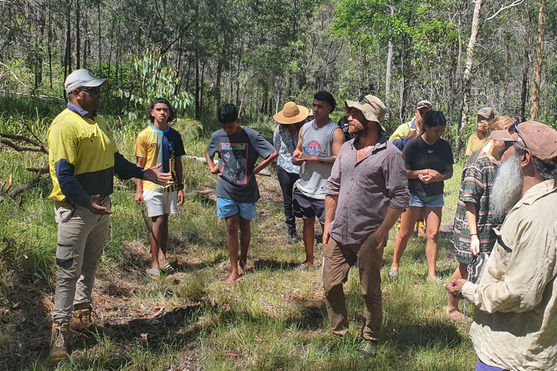Clarence Valley locals learn traditional fire management practices with support from FRRR

With flooding events dominating the headlines in the last 12 months, it’s hard to believe that Black Summer was only three years ago. But in Clarence Valley, where the fires destroyed 168 homes, even the recent floods haven’t distracted locals from the important task of preparing for fire.
“There’s still definitely concerns around the possibility of more fires,” says Mick Webb, the Area Manager for Environmental Services at Envite Environmental Services.
“It’s still in the back of people’s minds. Even though we’ve had flooding and increased rainfall recently, those concerns are still there.”
According to Mick, people in the community want to improve on their ability to protect their properties from bushfire risk. To do that, they are turning towards First Nations knowledge and practices, including the traditional land management technique of cool burning.
Mick explains that cool burning, also called mosaic burning, involves burning a very small area at a low intensity.
“It’s done in patches to allow areas for animals to escape,” he says. “It’s a manageable heat level and the flames are close to the ground.”
This year, Clarence Valley locals will have the opportunity to learn how to perform a cool burning at a series of workshops lead by first nations fire practitioner Charlie Little and facilitated by Envite Environmental Services.
Participants will learn how to plan a cool burn in the first workshop, including identifying the best time and place to perform the burn. In the second workshop, they will have the opportunity to perform a burn. They will return to learn how to evaluate the outcome of the burn in the third and final workshop.
The workshops are supported by a $20,000 grant from the Foundation for Rural and Regional Renewal (FRRR) as part of the bushfire recovery stream.
FRRR’s grants program manager April Merrick is impressed by the level of public support for the program.
“They trialled this in 2021, and it went really well,” she says. “They identified that there was a lot of interest in the community.”
She says that community members living on smaller parcels of land said that this type of land management was an easier way to protect the land from bushfires.
While it makes sense that people with property would want to learn how to protect it, Mick says that the interest in the workshops has been broader than that.
“People who don’t own land are interested in knowing why cool burning was used for thousands of years as a land management practise,” he says.
April applauds the program for drawing on traditional knowledge and passing it along to locals living in the area.
“It’s really good to have traditional owners doing cultural work on country and involving the local landowners who are interested in traditional practice,” she says.
The workshops will be filmed and used to help educate locals about the practice in the future.
“There’s a broader community benefit too,” April says.